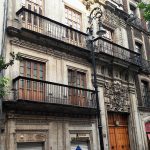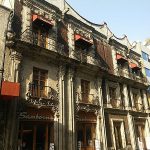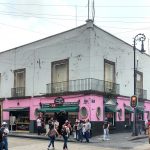La Casa del Conde de la Torre de Cossío es ampliamente reconocida como un excelente ejemplo de la arquitectura residencial del siglo XVIII en el centro de la Ciudad de México. Literalmente, la casa de los Condes de Torre Cosío y de la Cortina, fue la casa de Juan Manuel González de Cossío y de la Herrán. Se le concedió el título, por Real Cédula de Carlos III, en 1773. Fue reconocido como Señor de la Torre de Cossío, en el municipio de Rionansa, (Cantabria), con el mismo Decreto. La casa a veces también se conoce como la Casa de la Cortina, por José Justo Gómez de la Cortina, una figura social y política importante en los últimos años de la Nueva España.
Una placa en el edificio relata la siguiente historia. Se dice que la casa fue construida en una propiedad que perteneció a Juan Manuel Solorzáno. Solorzáno sospechaba de la infidelidad de su esposa, aunque todos los que conocía insistían en que era casta. Se dice que Solorzáno invocó al mismísimo diablo. El señor oscuro recomendó que Solorzáno matara al primer hombre que pasara por su casa, cada noche después de las 11. Solorzáno aceptó la oferta al diablo, pero antes de matar a sus víctimas, le preguntaba la hora. Entonces decía: “Bienaventurado el que conoce la hora de su muerte”. Mató a varias personas antes de arrepentirse finalmente. Buscando un sacerdote, su penitencia era rezar durante tres noches consecutivas en la horca. Al amanecer, después de su tercera noche, lo encontraron ahorcado
No hace falta decir que es uno de los lugares más embrujados de la Ciudad de México.
La estructura que siguió se completó en 1781. La fachada contiene una serie de características notables. Una torre de azulejos remata una torre de baluartes decorativos que evocan al siglo XVI. También hay canalones de lluvia en forma de barril. La fachada está revestida de tezontle y los marcos de puertas y ventanas son de piedra chiluca de cantera. La puerta principal está flanqueada por un espectacular arco de piedra tallada. Los pernos de metal decorativos son originales y fueron un signo de estatus y riqueza del siglo XVII. Nada del interior ha sobrevivido y la planta baja se ha adaptado para uso comercial.
Entre los Palacios del Centro de la Ciudad, la Casa del Conde de la Torre de Cossío no es el mejor conocido.Y aparte de los espacios comerciales en la planta baja, no está abierto al público. Sin embargo, la historia de las casas y su rica apariencia son parte de lo que hace que un paseo por el centro de la ciudad sea tan atractivo.
.

Cercano a 0.05 kms.

Cercano a 0.07 kms.

Cercano a 0.16 kms.

Uno de los lugares más importantes para ver obras de arte de la época colonial.

Fácilmente uno de los restaurantes históricos más famosos de la Ciudad de México...

En lo que hoy es un restaurante argentino, se hospedó un joven Simón Bolívar en 1799.

Una de las casas palaciegas del siglo XVIII en la Ciudad de México...

Un palacio verdaderamente grandioso del siglo XVIII en el centro de la ciudad.